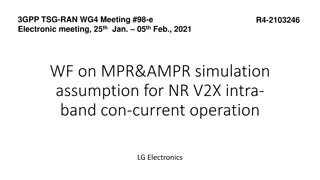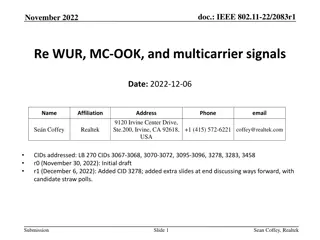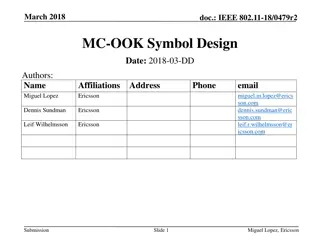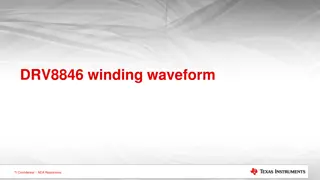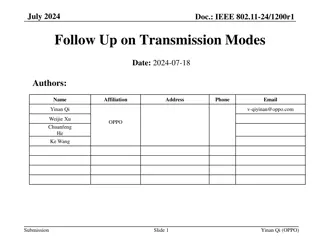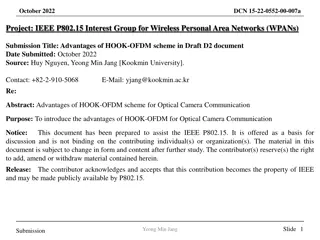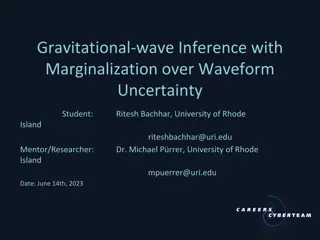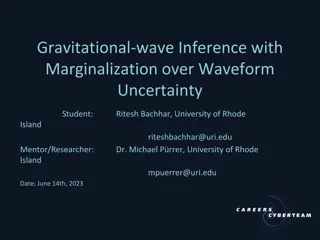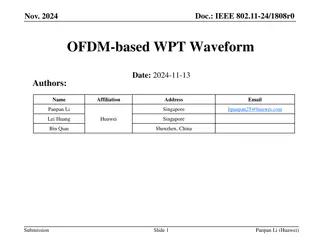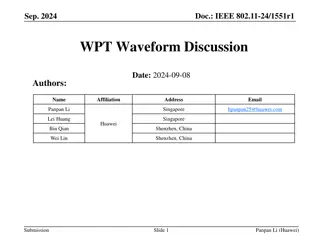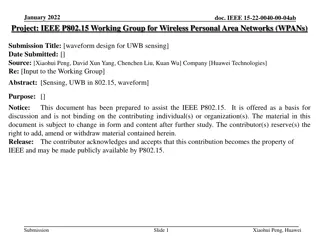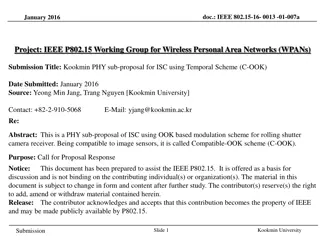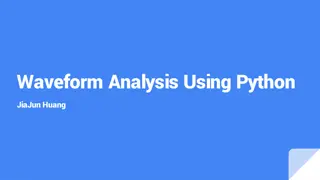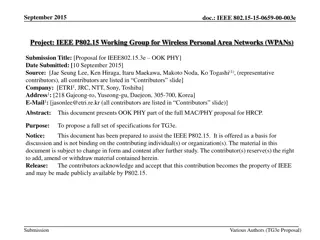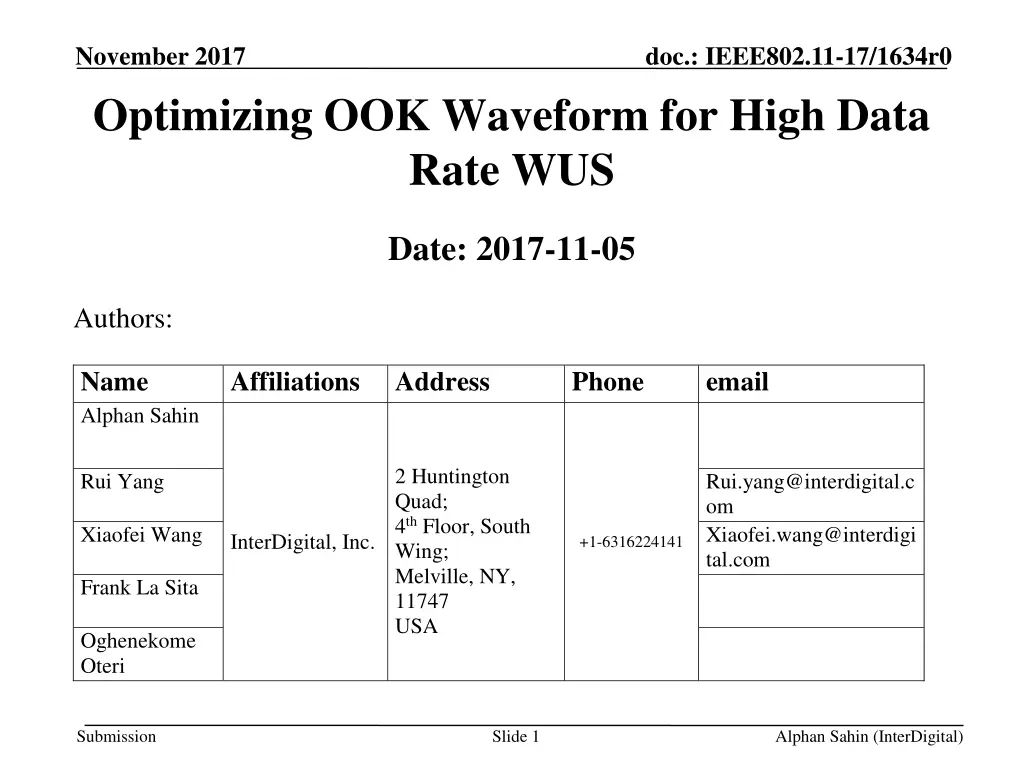
Optimizing OOK Waveform for High Data Rate Wireless Communications
In this document, a novel approach for generating waveform coded on-off keying (OOK) signals using frequency domain sequences with QAM symbols is proposed. This approach simplifies the transmitter structure, offers low complexity, and is hardware-friendly, supporting frequency domain multiplexing without requiring extra filtering. Additionally, constellation-based OOK schemes and design criteria for waveform sequences are discussed.
Download Presentation

Please find below an Image/Link to download the presentation.
The content on the website is provided AS IS for your information and personal use only. It may not be sold, licensed, or shared on other websites without obtaining consent from the author. If you encounter any issues during the download, it is possible that the publisher has removed the file from their server.
You are allowed to download the files provided on this website for personal or commercial use, subject to the condition that they are used lawfully. All files are the property of their respective owners.
The content on the website is provided AS IS for your information and personal use only. It may not be sold, licensed, or shared on other websites without obtaining consent from the author.
E N D
Presentation Transcript
November 2017 Optimizing OOK Waveform for High Data Rate WUS doc.: IEEE802.11-17/1634r0 Date: 2017-11-05 Authors: Name Alphan Sahin Affiliations Address Phone email 2 Huntington Quad; 4th Floor, South Wing; Melville, NY, 11747 USA Rui Yang Rui.yang@interdigital.c om Xiaofei.wang@interdigi tal.com Xiaofei Wang +1-6316224141 InterDigital, Inc. Frank La Sita Oghenekome Oteri Submission Slide 1 Alphan Sahin (InterDigital)
November 2017 doc.: IEEE802.11-17/1634r0 Introduction In this contribution, we propose an approach to generate waveform coded (WFC) on-off keying (OOK) waveform via frequency domain sequences consisting of ?-QAM symbols This approach offers a very simple TX structure Compatibility: Same as transmitting ?-QAM symbols due to the fact that ?- QAM based sequences are utilized Low-complexity: Generates 11ba OOK waveform without masking, hence supports frequency domain multiplexing (FDM) with trivial extensions Hardware-friendly: Controls out-of-band (OOB) emission and PAPR without extra filtering/windowing It is exactly aligned with the current agreements on 11ba waveform Agreement [1]: When a single band is used for transmission of WUR PPDU, the OOK waveform of WUR PPDU is generated by using contiguous 13 subcarriers with the subcarrier spacing of 312.5 kHz: The center subcarrier is TBD. At the baseband output, this approach yields WFC OOK symbols which exactly consist of 13 tones and the center tone (CT) can be nulled. Submission Slide 2 Alphan Sahin (InterDigital)
November 2017 doc.: IEEE802.11-17/1634r0 Constellation-based OOK Constellation-based OOK is a sequence-based scheme similar to proposals in [2-4], but it uses ?-QAM based sequences in the frequency domain To generate logic 0/1 WFC OOK symbols, a single sequence is utilized in forward direction (as logic 0) and backwards direction (as logic 1) order. When reversing the order of a sequence in the frequency domain (e.g., Logic 0 and Logic 1 sequences below), it reverses output of the IDFT except for the first element. Logic 1 OOK ?0 ?63 ?62 Logic 0 OOK Logic 0 sequence Logic 1 sequence ?0 ?1 ?2 Logic 1 Amplitude ?1 ?12 ?11 ?10 ?9 ?8 ?7 0 ?2 ?3 ?4 ?5 ?6 6 ?-QAM symbols Logic 1 sequence t Mapping IDFT (64) Add GI Logic 0 1 center tone 0 ?7 ?8 ?9 ?10 ?11 ?12 Amplitude ?6 Logic 0 sequence ?5 ?4 ?3 ?2 ?1 6 ?-QAM symbols t Data 0 ??? ?62 ?63 ?2 ?1 IDFT output Submission Slide 3 Alphan Sahin (InterDigital)
November 2017 doc.: IEEE802.11-17/1634r0 Design Criteria The WUR sequences can be designed based on the following criteria jointly: Fluctuation during ON duration PAPR = Peak/Average (defined in Appendix) Leakage during OFF duration Leakage Ratio: 100 Energy[Off]/Energy[On] (defined in Appendix) 11ac Spectral Mask Compliance Length of 13 with null CT Constellation size 64-QAM It is possible to design different WUR sequences based on other constellations, e.g., QPSK, 16QAM, 256QAM, by making tradeoffs between the criteria above Submission Slide 4 Alphan Sahin (InterDigital)
November 2017 doc.: IEEE802.11-17/1634r0 Example 1 - Prioritize PAPR First The following sequence with 64-QAM constellation minimizes the fluctuation during ON duration while keeping the leakage during OFF duration low and the WUS PSD compliant with the 11ac spectral emission mask Option 1: PAPR First Symbol ?(?) ?(?) -3 -1 -3 -7 7 5 0 1 1 3 -1 1 -1 Minimal fluctuation (1.08 dB PAPR) 3 -1 3 -7 -7 5 0 1 -1 3 1 1 1 ?1 ?2 ?3 ?4 ?5 ?6 CT ?7 ?8 ?9 ?10 ?11 ?12 ? ? = ?64QAM ?(?) + ?(?) 1 ?64QAM is the normalization factor for 64-QAM" For the plot, ? ?? ?(64) ?(23) ?(64) ?(5) ?(1) ?(42) 0 ?(51) ?(19) ?(60) ?(55) ?(51) ?(55) Leakage ratio = 2.55% 2= 1 over 4?s @ ?s= 20 MHz Submission Slide 5 Alphan Sahin (InterDigital)
November 2017 doc.: IEEE802.11-17/1634r0 Example 2 - Prioritize Leakage First The following sequence with 64-QAM constellation minimizes the leakage during OFF duration while keeping PAPR low and the WUS PSD compliant with the 11ac spectral emission mask Option 2: Leakage First Symbol ?(?) ?(?) ?1 ?2 ?3 ?4 ?5 ?6 CT ?7 ?8 ?9 ?10 ?11 ?12 ?(20) -1 5 5 -7 7 3 0 1 -7 -5 -3 3 1 3 5 Low fluctuation (1.91 dB PAPR) ?(42) ?(45) ?(3) ?(34) ?(61) 0 ?(53) ?(8) ?(11) ?(26) ?(60) ?(55) -7 1 5 -7 0 -7 -3 1 5 3 -1 ? ? = ?64QAM ?(?) + ?(?) 1 ?64QAM is the normalization factor for 64-QAM" For the plot, ? ?? Leakage ratio = 0.55% 2= 1 over 4?s @ ?s= 20 MHz Submission Slide 6 Alphan Sahin (InterDigital)
November 2017 doc.: IEEE802.11-17/1634r0 Example 3 - Prioritize OOB First The following sequence with 64-QAM constellation minimizes the OOB emission by forcing the first sample of the output of IDFT to be zero (zeroth-order continuity) Option 3: OOB First Symbol ?(?) ?(?) ?1 ?2 ?3 ?4 ?5 ?6 CT ?7 ?8 ?9 ?10 ?11 ?12 ?(23) -1 -3 -5 -1 1 7 0 7 -5 -1 7 -3 -3 -1 -3 3 3 7 1 0 -3 -7 7 -3 -5 1 Low fluctuation (1.6 dB PAPR) ?(32) ?(12) ?(20) ?(49) ?(35) 0 ?(40) ?(13) ?(17) ?(40) ?(30) ?(27) Zeroth-order continuity ? ? = ?64QAM ?(?) + ?(?) 1 ?64QAM is the normalization factor for 64-QAM" For the plot, ? ?? Leakage ratio = 1.75% 2= 1 over 4?s @ ?s= 20 MHz Submission Slide 7 Alphan Sahin (InterDigital)
November 2017 doc.: IEEE802.11-17/1634r0 Simulation Assumptions Constellation-based OOK: We consider the sequence option 1 (PAPR First), option 2 (Leakage First), and option 3 (OOB First) The OOK symbol + blank GI duration is 4??. Sampling rate Fs = 20 MHz (IDFT size is 64). 2nd order Butterworth filter (?3dB= 2.5 MHz, Fs = 20 MHz) is used at the 11ba receiver WUR compares the energy on first half and second half of the OOK symbols to detect the bit Channel for BER measurement: AWGN Submission Slide 8 Alphan Sahin (InterDigital)
November 2017 doc.: IEEE802.11-17/1634r0 OOB Emission While Option 3 (OOB first) significantly reduces the OOB emission, Option 1 (PAPR first) and Option 2 (Leakage first) still satisfy the 802.11ac SEM mask Submission Slide 9 Alphan Sahin (InterDigital)
November 2017 doc.: IEEE802.11-17/1634r0 BER Performance The performance difference between the options is within 0.1 dB Since option 2 (Leakage first) has lower leakage than the other sequence, it is slightly better Submission Slide 10 Alphan Sahin (InterDigital)
November 2017 doc.: IEEE802.11-17/1634r0 Summary Example 1 Example 2 Example 3 Prioritize OOB First Prioritize PAPR First Prioritize Leakage First PAPR during On duration 1.07 dB 1.91 dB 1.6 dB 2.55% 0.55% 1.74% 100 Energy[Off]/Energy[On] SNR @ BER = 1e-4 (AWGN) -4.65 dB -4.85 dB -4.7 dB OOB emission Low Very low Low Need extra operation (windowing & filtering & No No No masking) 13 tones at the baseband output Null DC tone at the baseband output Compliant with 11ac Mask Derived from same sequence Derived from same sequence Derived from same sequence Logic 1/0 Sequences Multiband (FDM) support Yes, straightforward Yes, straightforward Yes, straightforward Submission Slide 11 Alphan Sahin (InterDigital)
November 2017 doc.: IEEE802.11-17/1634r0 Conclusions In this contribution, we demonstrate that WFC OOK waveforms can be generated without extra operation in time by using 64- QAM sequences of length of 13 (with null center tone) in frequency This is aligned with the current agreement on 11ba OOK waveform It utilizes the existing 802.11n/ac IDFT and modulator (64-QAM) Supports FDM with straightforward extensions We show that Logic 1 and Logic 0 OOK symbols can be generated from the same base sequence by changing the order of its elements We provide three example sequences which prioritize PAPR (1.07 dB), or leakage, or OOB emission. All of the design options comply with the 802.11ac mask Submission Slide 12 Alphan Sahin (InterDigital)
November 2017 doc.: IEEE802.11-17/1634r0 References [1] Leif Wilhelmsson, Meeting Minutes July 2017, IEEE 802.11-17/1197r1 [2] Alphan Sahin, Rui Yang, Xiaofei Wang, Hanqing Lou, Frank La Sita, On the Coexistence of 802.11ax and 802.11ba Signals, IEEE 802.11-17/0659r3 [3] Alphan Sahin, Rui Yang, Xiaofei Wang, Performance Evaluation of OOK Waveform Coding Schemes with Impairments, IEEE 802.11-17/1037r2 [4] Alphan Sahin, Rui Yang, Xiaofei Wang, Waveform Coding Schemes for Frequency Domain Multiplexing, IEEE 802.11-17/1419r0 Submission Slide 13 Alphan Sahin (InterDigital)
November 2017 doc.: IEEE802.11-17/1634r0 SP Do you agree that the constellation-based OOK waveform should be considered as a candidate waveform for the 802.11ba? Y: N: A: Submission Slide 14 Alphan Sahin (InterDigital)
November 2017 doc.: IEEE802.11-17/1634r0 APPENDIX Submission Slide 15 Alphan Sahin (InterDigital)
November 2017 doc.: IEEE802.11-17/1634r0 Index-to-Symbol Mapping for 64-QAM ? ? = ?64QAM ?(?) + ?(?) 1 ?64QAM is the energy normalization factor for 64-QAM ? 1 2 3 4 5 6 7 8 9 10 11 12 13 14 15 16 ?(?) -7 -7 -7 -7 -7 -7 -7 -7 -5 -5 -5 -5 -5 -5 -5 -5 ?(?) 7 5 1 3 -7 -5 -1 -3 7 5 1 3 -7 -5 -1 -3 ? ?(?) -1 -1 -1 -1 -1 -1 -1 -1 -3 -3 -3 -3 -3 -3 -3 -3 ?(?) 7 5 1 3 -7 -5 -1 -3 7 5 1 3 -7 -5 -1 -3 ? ?(?) 7 7 7 7 7 7 7 7 5 5 5 5 5 5 5 5 ?(?) 7 5 1 3 -7 -5 -1 -3 7 5 1 3 -7 -5 -1 -3 ? ?(?) 1 1 1 1 1 1 1 1 3 3 3 3 3 3 3 3 ?(?) 7 5 1 3 -7 -5 -1 -3 7 5 1 3 -7 -5 -1 -3 17 18 19 20 21 22 23 24 25 26 27 28 29 30 31 32 33 34 35 36 37 38 39 40 41 42 43 44 45 46 47 48 49 50 51 52 53 54 55 56 57 58 59 60 61 62 63 64 Submission Slide 16 Alphan Sahin (InterDigital)
November 2017 doc.: IEEE802.11-17/1634r0 PAPR & Leakage Measurements Inverse DFT output (64 point) Off duration On duration PAPR measurement Amplitude time 64 33 3132 1 2 3 4 Smooth transition to reduce OOB 2 2 Leakage ratio = 100 sum ? 33:64 max ? 3:31 mean ? 3:31 PAPR = 10log10 2 2 sum ? 1:32 Submission Slide 17 Alphan Sahin (InterDigital)


